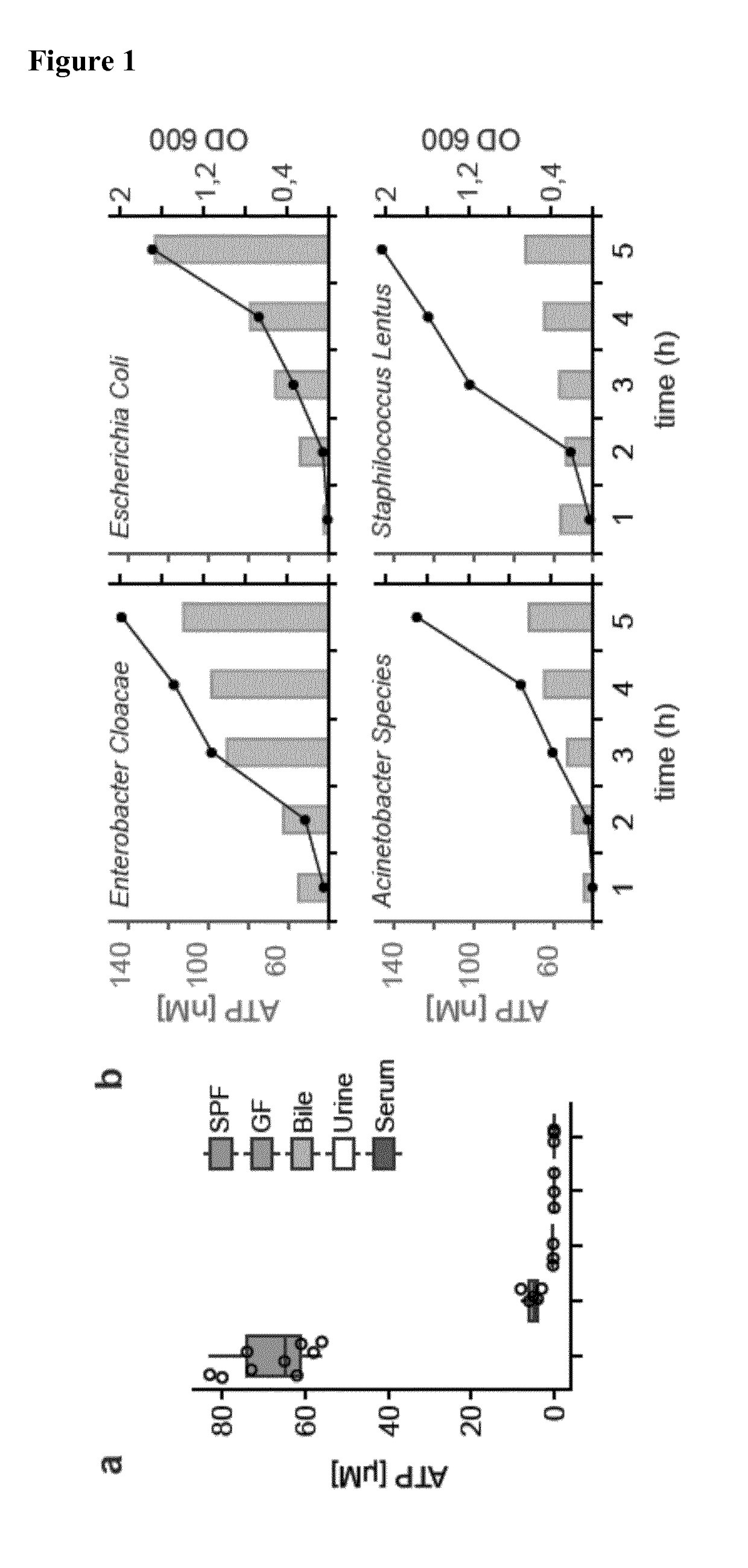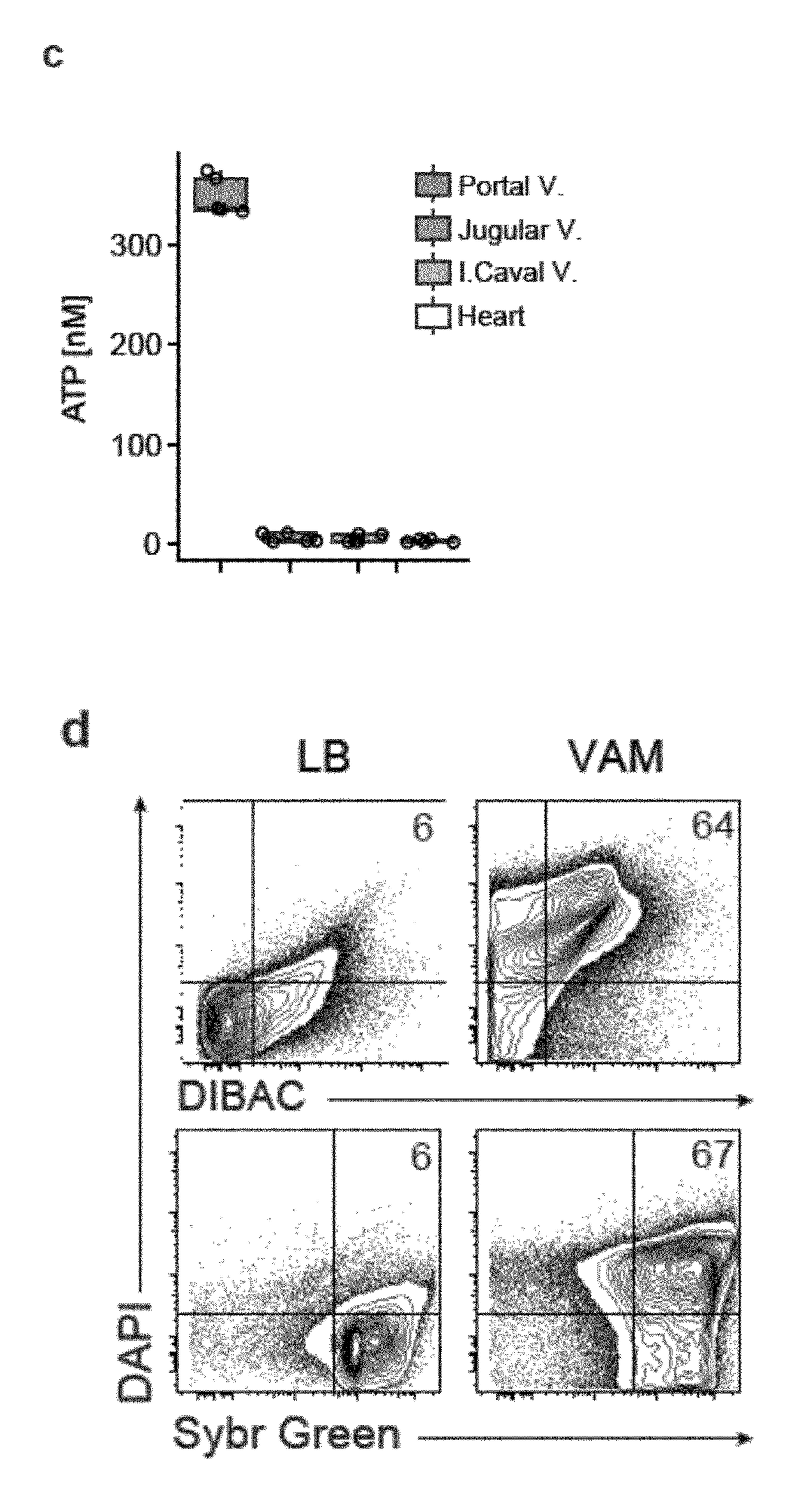Compositions
a technology of compositions and compositions, applied in the field of compositions, to achieve the effect of reducing the triggering of tfh cell death, and reducing the binding level of atp
- Summary
- Abstract
- Description
- Claims
- Application Information
AI Technical Summary
Benefits of technology
Problems solved by technology
Method used
Image
Examples
example 1
E. coli in Normally Colonized Mice
Detection of Extracellular ATP Levels Produced by Commensals
[0115]Extracellular ATP had previously been detected in the supernatant of in vitro cultured intestinal commensals derived from murine faeces5,6. In order to address whether the metabolic activity of commensals contributed to the level of intestinal ATP, the levels of ATP in the small intestine was observed in mice from a specific pathogen free facility and in entirely germ free mice. Micromolar concentrations of ATP were detected in the specific pathogen free mice, whereas ATP was barely detectable in the entirely bacteria free mice. It was found that fluids such as urine, bile and serum which originate from sterile (or almost sterile) epithelial or endothelial organs did not demonstrate a substantial amount of endoluminal ATP (see FIG. 1(a)). This finding indicates that mucosal colonization by commensals plays a role in increasing extracellular ATP levels.
[0116]To test whether bacteria pr...
example 2
E. coli in Germ-Free, Monocolonized Mice
[0126]The inventors monocolonized germ-free mice in order to demonstrate the effect of apyrase on endoluminal ATP levels, Tfh and germinal centre cell number and anti-E. coli IgA levels in a controlled experimental setting, in which the same amount of bacterial stimuli were present in the gut apart from extracellular ATP.
Reducing Endoluminal ATP in the Presence of Apyrase in Monocolonized Mice
[0127]Germ-free mice were monoclolonized by E. coli transformed with pHND10 or pBAD28. FIG. 4 shows that mice monocolonized with pHND10 harbouring E. coli showed significantly reduced concentration of endoluminal ATP in the intestine compared to mice monocolonized with pBAD28 harbouring E. coli and control mice. Germ-free mice which were not colonized with E. coli were used as a control.
Number of Tfh Cells and Germinal Centre B Cells are Increased in the Presence of Apyrase in Monocolonized Mice
[0128]Germ-free mice monocolonized with E. coli transformed w...
example 3
Attenuated Salmonella typhimurium in Normally Colonized Mice
[0132]Generating Salmonella typhimurium which Expresses Apyrase
[0133]To address whether apyrase expression in live attenuated Salmonella typhimurium could increase the specific IgA response and confer enhanced protection from infection by a virulent strain, the inventors used avirulent gyrA1816 Δcya1 Δcrp1 Salmonella typhimurium (ATCC® 53648™) (which includes mutations in cya and crp genes and is incapable of producing functional adenylate cyclase as well as cyclic AMP receptor protein) as a model vaccine. The inventors transformed S. typhimurium , with either pBAD28 or pHND10, as described above. As observed in E. coli, FIG. 7 shows that ATP was undetectable in culture medium of S. typhimurium carrying pHND10 (and therefore expressing apyrase) (see FIG. 7b) but was detected in increasing amounts that correlated with bacterial cell density in S. typhimurium carrying pBAD28 (and therefore not expressing apyrase) (see FIG. 7a...
PUM
| Property | Measurement | Unit |
|---|---|---|
| density | aaaaa | aaaaa |
| concentration | aaaaa | aaaaa |
| affinity | aaaaa | aaaaa |
Abstract
Description
Claims
Application Information
 Login to View More
Login to View More - R&D
- Intellectual Property
- Life Sciences
- Materials
- Tech Scout
- Unparalleled Data Quality
- Higher Quality Content
- 60% Fewer Hallucinations
Browse by: Latest US Patents, China's latest patents, Technical Efficacy Thesaurus, Application Domain, Technology Topic, Popular Technical Reports.
© 2025 PatSnap. All rights reserved.Legal|Privacy policy|Modern Slavery Act Transparency Statement|Sitemap|About US| Contact US: help@patsnap.com



